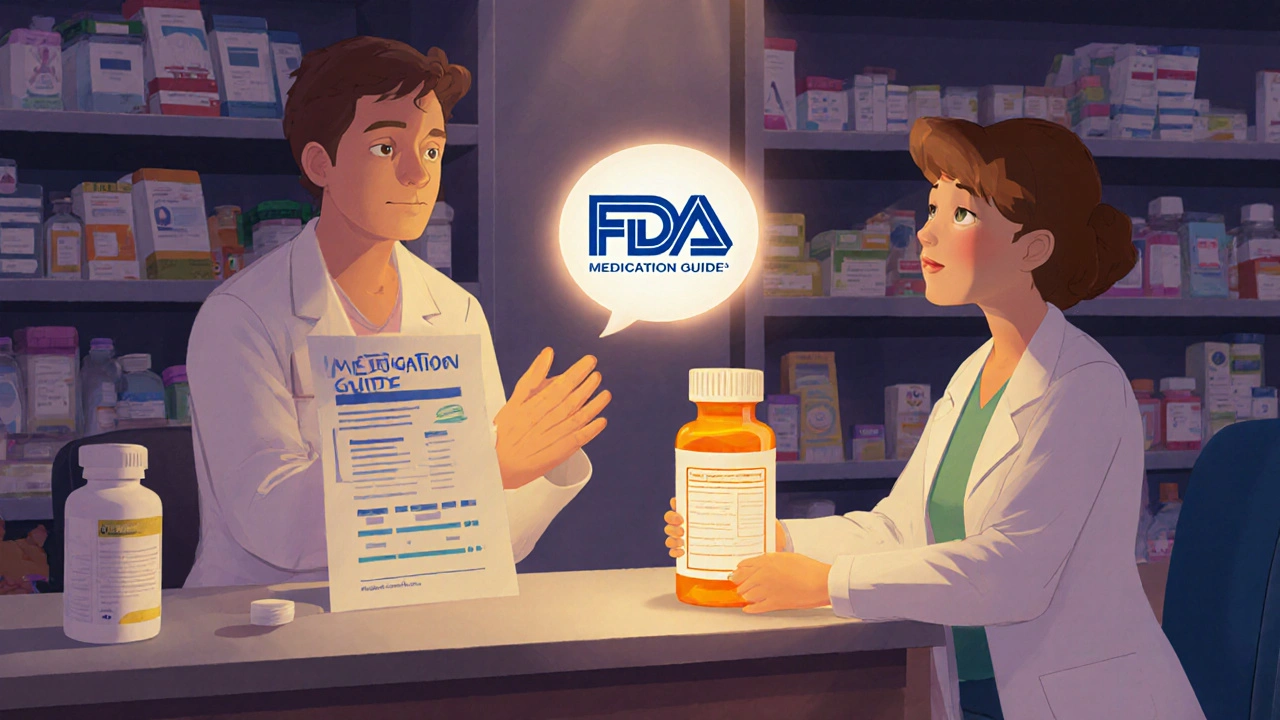
Medication Guide Checker
Check if your prescription drug requires a Medication Guide. Many drugs have serious risks that the FDA mandates must be communicated through these guides. You have the legal right to receive them at your pharmacy.
Medication Guide Information
How to Get Your Guide
Whether you receive a paper or electronic version, you have the right to:
- Ask for a Medication Guide when picking up your prescription
- Request an electronic version via email, text, or pharmacy app
- Ask for larger print if needed
- File a complaint if denied
When you pick up a prescription, you might not think twice about the small paper insert that comes with it. But for some medications, that paper isn’t just a reminder-it’s a legal safety document. The FDA requires certain prescription drugs to come with a Medication Guide, a printed patient information sheet designed to warn you about serious risks. And you have the right to get one-even if the pharmacy tries to skip it.
What Is a Medication Guide, Really?
A Medication Guide isn’t the same as the general leaflet that comes with your pills. It’s a specific, FDA-approved document created by the drug manufacturer and reviewed by the U.S. Food and Drug Administration. These guides are only required for drugs that carry serious risks-like life-threatening side effects, dangerous interactions, or risks that could lead to someone stopping treatment dangerously early. As of 2023, about 150 prescription drugs in the U.S. require a Medication Guide. That’s roughly 5% of all prescriptions. These include drugs for conditions like epilepsy, bipolar disorder, certain cancers, and even some antidepressants. The FDA only mandates these guides when the benefit of giving patients direct information outweighs the risk of them misunderstanding it. The rules are strict. The guide must be written in plain English, no smaller than 10-point font. The words “Medication Guide” must be clearly at the top, followed by the brand and generic name of the drug. At the bottom, it must say: “This Medication Guide has been approved by the U.S. Food and Drug Administration.” No marketing language. No fluff. Just facts.Your Legal Right to Get a Printed Copy
Under FDA regulations (21 CFR §208.24), pharmacies are required to give you a printed Medication Guide when you pick up your prescription-if the drug requires one. This isn’t optional. The pharmacist must hand it to you at the time of dispensing, not just leave it on the counter or say, “It’s on the shelf if you want it.” But here’s the catch: you don’t have to accept a paper copy. In May 2023, the FDA updated its rules to allow patients to request an electronic version instead. That means if you prefer to get the guide via email, text, or through your pharmacy’s app, you can ask for it. The pharmacy cannot refuse your request or pressure you into taking paper. If you’ve ever been handed a prescription without a guide and you know the drug requires one, you’re not imagining things. A 2022 survey by the National Consumers League found that 43% of patients never received their required Medication Guide. That’s not a mistake-it’s a violation.Why Pharmacies Sometimes Skip the Guide
It’s not that pharmacists don’t care. Many do. But the system is broken. Pharmacists are under constant pressure. A 2021 study found it takes 15 to 20 seconds per prescription to verify and hand out a Medication Guide. During busy hours, that’s time they don’t have. Many pharmacies, especially independent ones, still rely on manual systems. They get bulk shipments of guides from manufacturers, but if they run out, they can’t print a new one unless they have the right software. Chain pharmacies like CVS and Walgreens mostly use digital systems that print guides on-demand, but even they have gaps. A 2022 audit by the Department of Health and Human Services found that 31% of pharmacy sites had poor tracking systems for Medication Guides. Some pharmacists assume patients won’t read them. One Reddit thread from February 2023 had over 140 comments from pharmacists, and 63% admitted they sometimes skip handing out guides because “the patient didn’t ask” or “they looked overwhelmed.” But the law doesn’t care if you look busy. It requires the guide be given-period.
What If the Guide Is Hard to Read?
Even when you get the guide, it’s not always easy to understand. A 2023 analysis by the American Society of Health-System Pharmacists found that 68% of Medication Guides are written at an 11th-grade reading level or higher. That’s too complex for many adults. The FDA says they must be in “nontechnical” language, but too many guides still use medical jargon like “hepatic impairment” or “QT prolongation.” If you can’t read it, ask for help. Pharmacists are trained to explain these guides. Don’t be shy-say, “I don’t understand this part.” They’re there to help. If the font is too small, ask for a larger print version. Some pharmacies have magnifiers or can print a bigger copy if you ask.What’s Changing in 2025 and Beyond
The FDA is phasing out the current Medication Guide system. By 2027, they plan to replace all of them with a new format called “Patient Medication Information” (PMI). This will be a single-page, standardized document that looks the same for every drug. No more wildly different layouts. No more confusing formats. Just clear, consistent, easy-to-read info. The goal? Improve understanding. FDA testing showed patients understood PMI 37% better than current guides. That’s huge. But it’s also expensive. Pharmacies will need to upgrade their systems. Independent pharmacies could spend $2,500. Big chains might spend up to $15,000. The total cost? Around $500 million across the industry. For now, though, the old rules still apply. You still have the right to a printed Medication Guide if your drug requires one.How to Make Sure You Get Your Guide
Here’s what to do the next time you pick up a prescription:- Check if your drug requires a Medication Guide. You can search the FDA’s list at fda.gov/drugs (though it’s not always easy to find-ask your pharmacist if you’re unsure).
- When you get your prescription, ask: “Does this drug come with a Medication Guide?” Don’t wait for them to offer it.
- If they say no, say: “I’m entitled to one under FDA regulations. Can you print it for me?”
- If they say they’re out of copies, ask: “Can you print it from your system?” Most pharmacies have digital access.
- If they still refuse, ask to speak to the manager. Say: “I’d like to file a complaint with the FDA if I don’t get this guide.”
- Or, request an electronic copy. Say: “I’d prefer to receive it by email or through the app.”
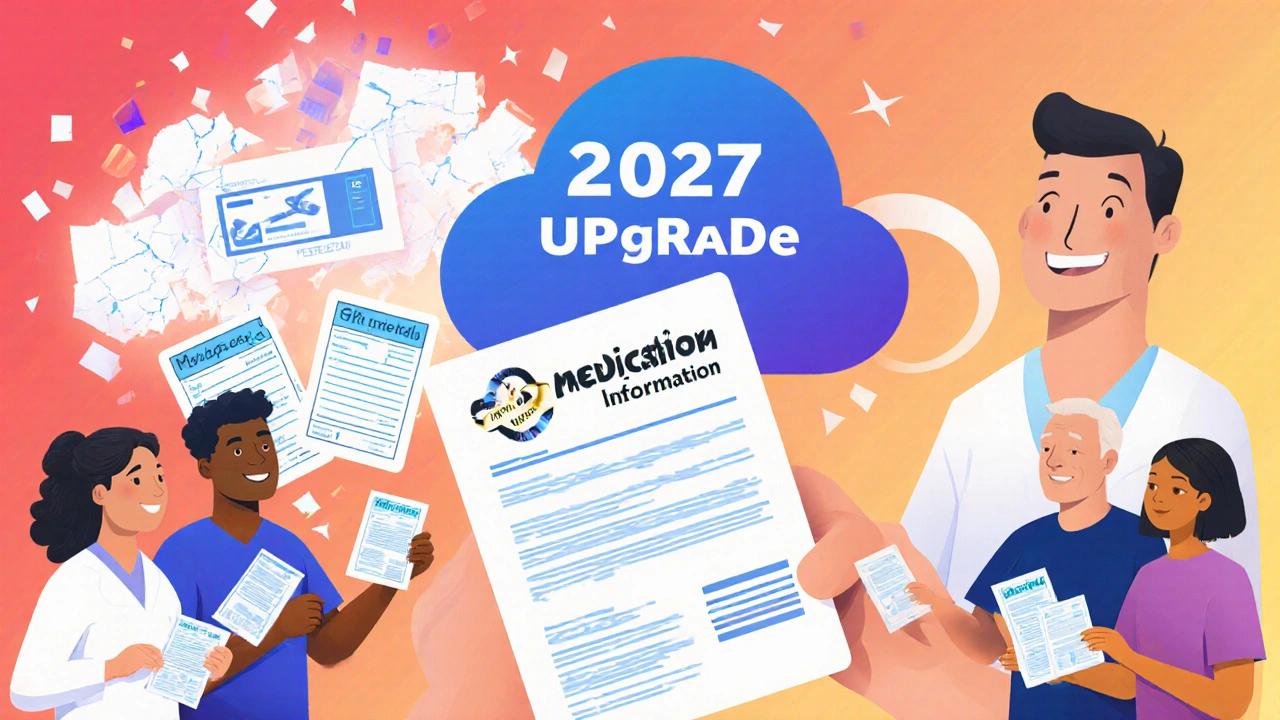
Real Stories: When the Guide Made a Difference
Patients aren’t just reading these guides for fun. A 2022 survey by Patients for Safer Drugs collected 347 stories. In 78 of them, the Medication Guide helped prevent a serious problem. One woman filled a prescription for an antidepressant and read the guide. It warned about serotonin syndrome when mixed with migraine medication she was already taking. She called her doctor before starting the new drug. She avoided a dangerous interaction. Another man with diabetes read the guide for his new blood pressure pill. It mentioned a risk of low potassium. He hadn’t known to get his levels checked. He scheduled a blood test-and caught a problem early. These aren’t rare cases. They’re proof that when patients get the right information, they can protect themselves.What to Do If You’re Denied a Guide
If a pharmacy refuses to give you a Medication Guide when it’s required, you have options:- Ask for a written explanation. Say: “Can you tell me why I’m not getting this guide?”
- File a complaint with the FDA. You can do it online at fda.gov/medwatch. Include the drug name, pharmacy name, and date.
- Report it to your state pharmacy board. They regulate pharmacies and can investigate.
- Tell your doctor. They may be able to switch you to a similar drug that doesn’t require a guide-or push the pharmacy to comply.
Final Thought: Your Health Is Your Responsibility
Pharmacies are busy. Pharmacists are overworked. But you’re the one who takes the pill. You’re the one who lives with the side effects. You have the right to know the risks. Don’t wait for someone to hand you a guide. Ask for it. If they say no, ask again. If they still refuse, speak up. You’re not being difficult. You’re being smart. The system isn’t perfect. But your voice can make it better.Do I have to accept a paper Medication Guide, or can I get it electronically?
You can choose. Under FDA rules updated in May 2023, pharmacies must give you the option to receive your Medication Guide electronically-by email, text, or through their app. They cannot force you to take a paper copy. If you prefer digital, just ask.
What if my pharmacy says they don’t have the guide in stock?
Pharmacies are required by law to have a way to provide Medication Guides when needed. If they’re out of printed copies, they should be able to print one on demand using a digital system. If they can’t, they’re not complying with FDA regulations. Ask them to print it or send you an electronic copy.
Are all prescription drugs required to have a Medication Guide?
No. Only about 150 out of thousands of prescription drugs require one. These are drugs with serious risks-like life-threatening side effects, dangerous interactions, or risks that could lead to harm if not taken exactly as directed. The FDA decides which drugs need a guide based on safety data.
Can I request a larger print version of the guide?
Yes. While the FDA requires a minimum 10-point font, there’s no maximum. If the text is too small to read, ask the pharmacist to print a larger version. Most digital systems allow you to adjust the print size. If they say they can’t, ask them to email you a copy you can print at home.
Why do some Medication Guides seem confusing or too technical?
Even though the FDA requires plain language, many guides still use medical terms. A 2023 study found 68% are written at an 11th-grade reading level or higher. If you don’t understand it, ask your pharmacist to explain. You’re not expected to decode medical jargon on your own.
Will Medication Guides disappear soon?
They’re being replaced. By 2027, the FDA plans to replace all current Medication Guides with a new format called Patient Medication Information (PMI). PMI will be a single-page, standardized document with consistent design and language across all drugs. Until then, your rights to a printed or electronic Medication Guide remain in effect.

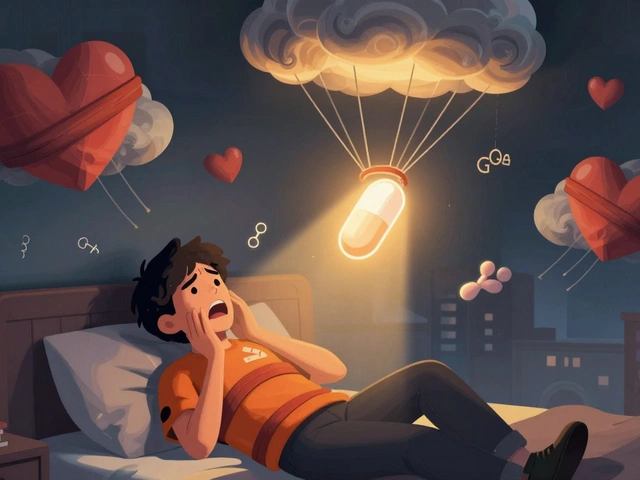

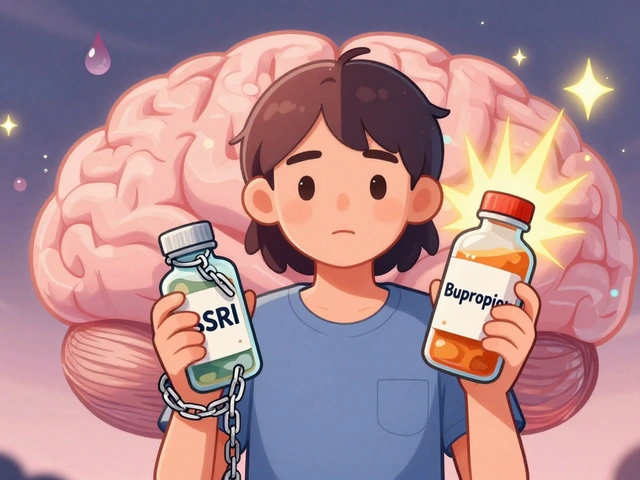
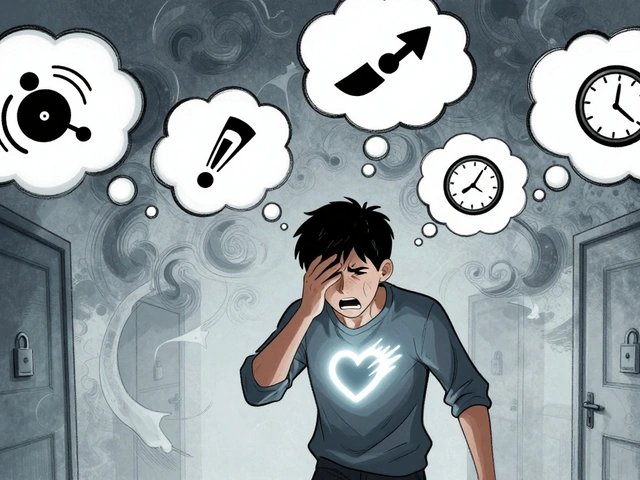

11 Comments
The FDA’s Medication Guide requirements are a classic case of regulatory overreach wrapped in patient safety rhetoric. The jargon-heavy language, inconsistent formatting, and lack of standardization defeat the entire purpose. Why not just mandate a unified PMI format from day one instead of patching a broken system for two decades? The 11th-grade reading level threshold is laughable-most adults struggle with medical terminology even at that level. This isn’t patient empowerment; it’s bureaucratic theater with a side of liability mitigation.
I’ve worked in community pharmacy for 18 years, and I can tell you-this isn’t about laziness. It’s about systemic failure. We’re stretched thin, understaffed, and often handed bulk guides that are outdated before they arrive. But here’s the thing: when patients ask for the guide, we drop everything. I once had a woman with bipolar disorder read her lithium guide and realize she’d been taking it with ibuprofen daily-she called her psychiatrist before her next refill. That’s why we do this. It’s not about compliance-it’s about saving lives. Ask for it. You’re not being difficult. You’re being the reason this system still works.
WAIT. So the FDA is forcing pharmacies to give out these guides… but they’re also secretly replacing them with a new system? Who’s really controlling this? I’ve seen the same drugs have different guides printed at different pharmacies. And why does the government care so much about paper inserts but not about the 500+ drugs that cause liver failure and no one even knows? This smells like a cover-up. They want you to think you’re safe with these guides… while quietly phasing them out so they can say ‘we fixed it’ later. The real agenda? Corporate liability shielding. They don’t want you reading the fine print-they want you to trust the system. Don’t be fooled.
While the intent behind the Medication Guide initiative is commendable, its implementation remains fraught with logistical and operational inefficiencies. The regulatory framework, though well-intentioned, lacks uniform enforcement mechanisms at the state level, resulting in inconsistent compliance. Furthermore, the transition to PMI by 2027, while technologically progressive, imposes significant financial burdens on small-scale independent pharmacies, potentially exacerbating disparities in healthcare access. A more equitable solution would involve federal subsidies for system upgrades, rather than placing the burden solely on frontline providers.
OMG I JUST REALIZED-my pharmacist didn’t give me the guide for my antidepressant last month and now I’m paranoid I’m gonna turn into a zombie and kill someone. I didn’t even know I had a right to it. I’m gonna text my whole family and tell them to demand these things. Like, what if I had been on this drug for 3 years and never read the part about serotonin syndrome? I could’ve died and no one would’ve known it was because the pharmacy didn’t hand me a piece of paper. This is literally life or death and they treat it like a coupon!
It’s easy to blame pharmacists, but let’s be real-they’re drowning. I’ve seen them juggle 12 prescriptions at once while calming a crying kid and explaining why insulin costs $300. The system is broken, not the people. But here’s what you can do: ask politely. Say ‘I’d really appreciate the guide’-it makes them more likely to go out of their way. And if they say they’re out? Ask for the digital version. Most apps let you download it instantly. You’re not asking for a favor-you’re exercising a right. And that’s powerful.
The philosophical underpinning of this regulation is sound: informed consent is non-negotiable in medical ethics. However, the practical execution reveals a dissonance between policy and reality. The FDA’s reliance on printed documentation assumes a level of patient engagement and health literacy that is not universally present. While the forthcoming Patient Medication Information (PMI) initiative represents a step toward standardization, true equity requires complementary educational outreach, multilingual resources, and accessible digital interfaces-not merely regulatory mandates. The goal should be comprehension, not compliance.
I used to ignore these guides until I started taking gabapentin and saw the part about suicidal thoughts in young adults. I was 22 and had no idea. I called my doctor and he adjusted my dose. Now I always ask. If you don’t know the drug requires one, just say ‘Do I get a Medication Guide with this?’ They’ll usually say yes. If they say no, ask again. And if they still say no, ask for the manager. Seriously. It takes 10 seconds. You’re worth it. Don’t let them rush you. Your body is your business.
India has better drug safety systems than this. We have mandatory patient counseling and doctors are legally required to explain side effects. Why is America so lazy? Pharmacies here act like they’re doing you a favor by handing you a paper. The FDA is a joke. This whole system is designed to protect big pharma not patients. You want real safety? Ban the crap that needs these guides in the first place. Stop selling dangerous drugs and start holding manufacturers accountable. We don’t need more paper-we need less poison.
I appreciate the effort behind this post. Honestly, most people don’t know these guides exist, let alone their rights. I’ve had patients thank me after I explained their guide-they felt like they finally understood what they were taking. It’s not about the paper, it’s about the conversation. If you’re ever unsure, ask. Don’t feel bad. We’re here to help. And if you get a digital copy? That’s fine too. The goal is understanding, not the format.
The Medication Guide is a sham. It’s a compliance checkbox for Big Pharma. The real danger is in the drug approval process itself-where corporate lobbying overrides clinical evidence. The FDA approves drugs with deadly side effects then hides behind these guides like they’re a shield. The 150 drugs requiring guides? That’s just the tip of the iceberg. There are hundreds more with black box warnings that never get printed. This system isn’t protecting you-it’s giving the illusion of protection so the industry can keep selling. Demand transparency. Not paper.